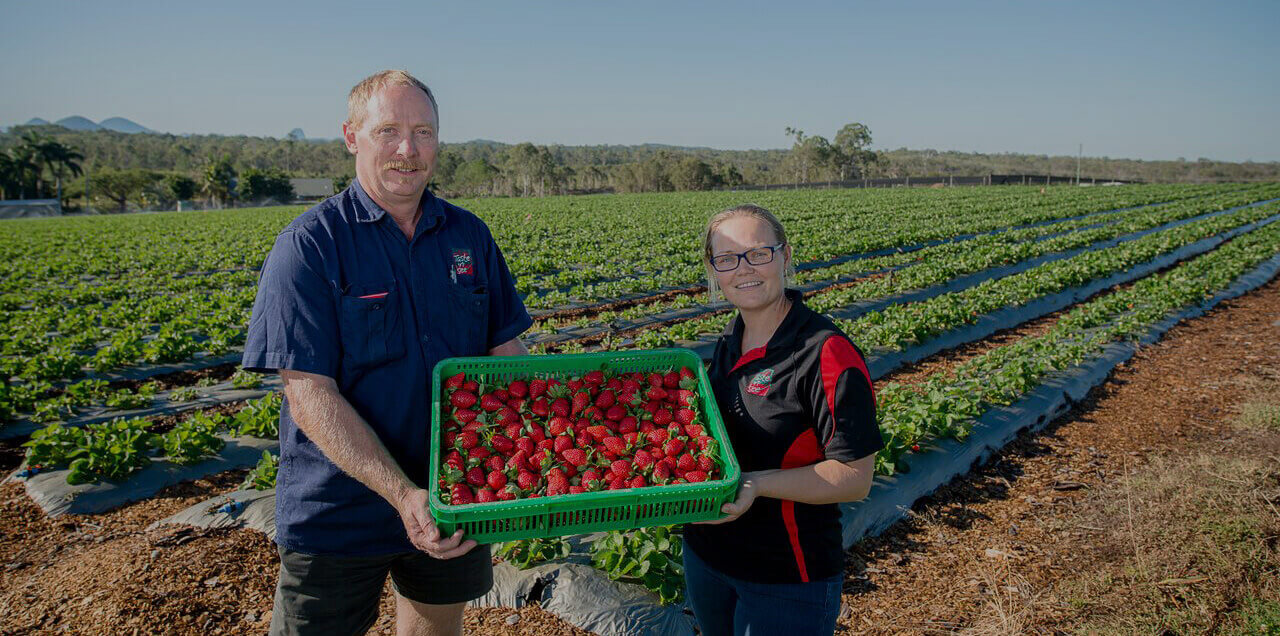The Sweetest Job
- Outside-in
- Health Sector
- Moreton Bay & Sunshine Coast regions

The Challenge
Strawberry farmers in the Moreton Bay and Sunshine Coast regions were at risk of not being able to access a reliable, sustainable and capable workforce. The challenge was to secure a returning workforce consisting of experienced local employees rather than a ‘one season only’ backpacker workforce that required training each season.
The Solution
- To increase awareness of local jobs on strawberry farms
- To build a more stable and sustainable local workforce by increasing the percentage of locals employed and reducing reliance on an overseas workforce
- To build the skills and capacity of local job seekers who may have otherwise faced barriers to employment, by providing training in agribusiness qualifications and wraparound job support
Implementation
A collaborative alliance was formed to develop a local recruitment initiative, with a campaign to attract and engage job seekers on strawberry farms within the Sunshine Coast and Moreton Bay regions. The initiative involved a comprehensive social media campaign to raise local awareness, and encourage them to register their interest to attend information sessions. A workforce intermediary coordinated recruitment and placement activities. Following the success of the initial campaign, State Government funding was secured to deliver a Skilling Queenslanders for Work (SQW) program. This enabled the initiative to be extended to include accredited training and job readiness support for disadvantaged job seekers. In addition, job placements were broadened to include the wider agribusiness sector within the region.
Organisational strategies
- Farm employers educated team supervisors about local employment goals and involved them in the induction process.
Partnership strategies
- A collaborative partnership was formed to maximise outcomes and reduce the burden of recruitment cost, time and resourcing on individual farmers.
- Regular meetings enabled project partners to fine tune the program when necessary.
- Project partners leveraged Moreton Bay and Sunshine Coast Councils’ media expertise and networks to maximise publicity.
- Links were made with local community groups and jobactive providers to leverage their connections to local job seekers of all ages and backgrounds.
- Partnerships were formed with local training providers to deliver agribusiness qualifications.
Program design strategies
- A multi-faceted social media campaign promoted the availability of local jobs on strawberry farms. Interested job seekers were required to complete an online registration form.
- Information sessions promoted the jobs available and provided an overview of agriculture work.
- A workforce intermediary undertook end-to-end recruitment services using project funding.
- The project focused on assisting disadvantaged local job seekers, including Aboriginal and Torres Strait Islander peoples, culturally and linguistically diverse job seekers, mature-aged job seekers, under-employed workers, and women wanting to re-enter the workforce. Comprehensive wraparound support was provided to help overcome employment challenges.
- Training cohorts were formed for specific qualifications.
- Work experience placements exposed candidates to jobs and employers to candidates.
Results
- In the 2016 initiative, over 2,500 job seekers engaged in the project and over 130 job seekers were employed.
- On average the five farms actively involved in the project reported a 40% to 50% increase in the number of locals they employed in 2016.
- In the 2017/2018 project, 117 job seekers were engaged in the program. Of these, 92 have achieved qualifications and 62 have gained employment as at May 2018.
Lessons Learned
- Collaborative partnerships lighten the load, share costs, leverage strengths and maximise outcomes.
- Clear roles for project partners avoids duplication and improves accountability.
- A financial contribution by employers helps to achieve greater buy-in and commitment to achieving employment targets.
- It is important to provide realistic numbers of the actual number of jobs available.
- Local jobs need to be advertised via the channels that local job seekers would normally access.
- To ensure a good match, employers/hiring managers need to be involved in helping workforce intermediaries to develop screening questions for candidates.
- To ensure training leads to genuine employment outcomes, jobs should be reserved for training participants.
REQUIREMENTS FOR
REPLICATION
Do you…
- have an understanding of the sector’s skill needs and an ability to align training to address these needs?
Can you…
- access a pool of local job seekers with a genuine interest in working in the sector?
- collaborate and form partnerships?
- establish strong networks with the local media, jobactives and local councils?
- utilise social media to promote the program?
CONSIDERATIONS FOR PROGRAM SCALING
Do you…
- have an understanding of local workforce requirements and an ability to match scale of the program accordingly?
POTENTIAL RISKS
What if…
- the workers engaged are not work ready or adequately trained so trust in the project is diminished?
- the number of workers required is miscalculated?
